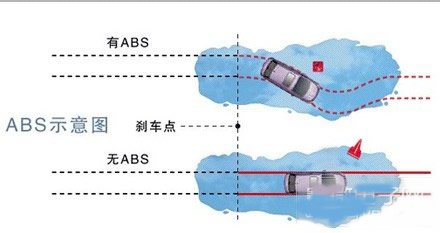The full name of the anti-lock brake system in English is the Anti-lock Brake System, referred to as ABS, which can be installed on any car with a hydraulic brake system. The anti-lock brake system uses the rubber airbag inside the valve body. When the driver presses the brake, the brake oil pressure will be filled into the valve body of the ABS. At this time, the airbag reuses the air compartment in the middle to return the pressure. The wheel will avoid the lock point. This paper briefly introduces the principle of the anti-lock braking system of the car and some advantages and precautions of the system. I believe it will definitely help the readers' learning!
This article refers to the address: http://
The anti-lock brake system was initially applied to the train and later gradually used on the aircraft. The system is now very popular. At present, such systems are seen on cars of more than 100,000 yuan, and even some buses have already installed the system. Vehicles equipped with anti-lock braking systems experience some bad weather. When the road surface is snowy, frozen or rainy, the driver can safely operate the steering wheel and brake. The system not only effectively prevents accidents, but also reduces friction on the tires. But this is the system and can't be a car to shorten its set distance, and in some cases even increase the braking distance.
Principle of anti-lock braking system

When braking, ABS can quickly judge the locked state of the wheel according to the speed signal transmitted by each wheel speed sensor. Close the normally open input solenoid valve on the wheel to stop the brake force, if the wheel continues When locked, the normally closed output solenoid valve is opened. The brake pressure on this wheel is quickly moved down due to the passage of the through brake fluid storage tank, preventing the wheel from being completely locked due to excessive braking force.
At the same time, the main control valve is energized to open, the dynamic pressure brake fluid can enter the brake valve, and the dynamic pressure brake fluid reaches the front wheel input from the dynamic boost line through the main control valve and the outer periphery of the brake master cylinder seal. The pipeline works repeatedly (operating frequency 3-12 times/second), so that the braking state is always at the optimum point (slip rate S is 20%), the braking effect is best, and the driving is the safest.
The brake fluid in the front chamber of the master cylinder is a dynamic pressure brake fluid that pushes the reaction sleeve to the right, which in turn pushes the booster piston to move the brake pedal pusher to the right. Therefore, when the ABS is working, the driver can feel the pedals vibrating and hear some noise.
After the car decelerates, once the ABS computer detects that the wheel lock state has disappeared, it will cause the main control valve to close, thereby causing the system to go into normal braking state to work. If the accumulator pressure drops below the safe limit, the red brake fault indicator and the amber ABS fault indicator light.
In this case, the driver must brake the deep pedal with a large force to effectively brake the front and rear wheels.
Advantages of anti-lock braking system
1. Effectively shorten the braking distance. In the emergency braking state, ABS can make the wheel in the condition of rolling and dragging, and the proportion of dragging is about 20%. At this time, the friction between the tire and the ground is the largest, the so-called optimal braking point or area. Ordinary braking systems cannot do this.
2. Strengthen the control of the vehicle. In vehicles equipped with ABS, the driver can still maintain a large degree of maneuverability during the emergency braking process, and can adjust the direction in time to make timely and necessary avoidance of the obstacles or dangers ahead. Vehicles that are not equipped with ABS are prone to accidents such as side slips and tails during emergency braking, which causes the driver to lose control of the vehicle and increase the risk.
3. Reduce the wear of the tires. The use of ABS eliminates the wheel that is locked during emergency braking, causing the tire to suffer irreparable damage, ie the possibility of forming a flat spot on the surface of the tire. Everyone will notice that the long brakes on the road are not equipped with ABS vehicles, and the vehicles equipped with ABS will only leave a slight brake trace, and it is a short paragraph, which is obviously reduced. The degree of wear on the tires and the ground.
4. Reduce the phenomenon of floating. Vehicles without ABS are braked on wet, smooth roads. After the wheels are locked, the vehicle will remain inert on the road and continue to slide forward. The ABS also reduces the chance of slippage during braking due to the reduced chance of wheel lock.
Car anti-lock brake system notes:
(1) Unplug the power supply before checking the ABS anti-lock brake system.
(2) After replacing the brake or replacing the hydraulic brake system components, the air in the brake pipe should be drained to avoid affecting the normal operation of the brake system.
(3) For vehicles equipped with ABS, the brake fluid should be replaced once a year. Otherwise, the brake fluid is highly hygroscopic, and not only will it lower the boiling point, cause corrosion, but also cause a decline in braking performance.
The above is some of the knowledge that Xiaobian introduced to you about the principle of the anti-lock brake system of the car. I believe that under the explanation of Xiaobian, all readers have an understanding of this knowledge. In the event of an emergency, the brake pedal must be carefully stepped on to the end, in order to activate the ABS system, this time the brake pedal will be a little jittery, and occasionally there will be some blunt, but be sure not to loosen, this time ABS system It started to work.
Optical coupler is also called optical splitter , is one of the most important passive devices in optical fiber link, is with multiple inputs and multiple output end of the optical fiber connected devices. The fiber optic splitter by the light splitting principle can be divided into the fused biconical taper (FBT type) and planar waveguide type (PLC type).
PLC Splitter, With SC/APC Connector,SC/UPC Connector, LC/APC Connector , LC/UPC Connector
Bwinners Telecom Communication products include: Fiber Optic Splice Closure, FTTH Fiber Optical Distribution Box, FTTH Fiber Optic Socket Face Plate, Fiber Optic Patch Panel Terminal Box, ODF Optical Fiber Distribution Frame, OCC Optical Fiber Cross Connection Cabinets, Network Cabinet, Equipment Enclosure, PLC Splitter, Fiber Optic Patch Cord , Fiber Optic Adapter , Fiber optic pigtail, FTTH Accessories, etc.
Bwinners Equipment Enclosure includes all kinds of Equipment Enclosure, wall mounting enclosure, junction box, network box, electrical enclosure box, stainless steel enclosure, electronic equipment racks, metal cabinets, metal enclosure CATV enclosure, etc.



fiber optic splitter plc, fiber optic cable splitter, optical splitter, Mini Type PLC Splitter, Cassette Type PLC Splitter, Insertion Module PLC
Sijee Optical Communication Technology Co.,Ltd , https://www.sijee-optical.com